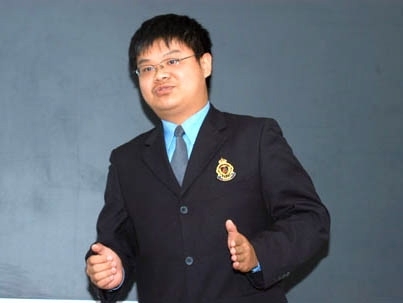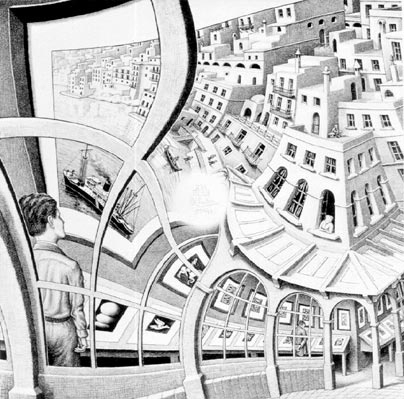Editor's note: Wang Dong is a high school student from China who worked as an intern in the MIT News Office this summer through the Research Science Institute, the focus of this piece. His goal is to become a science writer.
Eighty-eight of the world's top high school students spent six weeks at MIT this summer engaged in advanced research ranging from the mathematics of an Escher painting to a space mission for mice.
The students, from 34 states and 17 countries in Asia, Europe and the Middle East, were here for the 22nd Research Science Institute (RSI). Sponsored by the Center for Excellence in Education (CEE) and MIT, the program combines coursework in scientific theory with research internships at Boston-area universities, including MIT and Harvard.
Artful Mathematics
Asilata Anand Bapat of India said at the beginning of the program that she hoped to find the perfect combination of mathematics and art in her research. She studied "Print Gallery," Maurits Cornelis Escher's famous painting.
Escher was a Dutch artist best known for his woodcuts, lithographs and mezzotints, which tend to feature impossible constructions, explorations of infinity and tessellations.
"Print Gallery" shows a young man standing in a gallery, viewing a print of a Mediterranean seaport. If you follow the quayside buildings shown on the print from left to right and then down, the scene inside the painting slowly becomes the exterior of the gallery in which the man is standing.
Escher left a circular white patch in the center of the picture in which he placed his monogram and signature. For years, people have wondered whether it is possible to continue the picture into the patch.
In 2003, B. de Smit and H. W. Lenstra Jr. of the Netherlands found a mathematical algorithm for the curves in the picture, allowing them to fill in the hole. The mathematically ideal version contains the same picture repeated in the center an infinite number of times, but rotated by a certain angle and scaled down each time.
Bapat said she was very interested in the algorithm, and hoped that she could do more than just "fill in the blank."
For example, the existing algorithm works just for "Print Gallery," but Bapat is looking for a way to apply the same formula to other pictures. She is also studying whether the picture can be distorted in a different way. The outermost image in "Print Gallery" is distorted clockwise, but creating a counterclockwise one, for example, may also be possible.
Bapat's mentor, Aaron Tievsky, was himself an RSI student in 1998. Today he is an MIT graduate student in the Department of Mathematics.
Mice in Space
Tewfik Cassis of Egypt and Patrick El-Hage of Lebanon worked on a project that could aid future missions to Mars.
The goal of the student-driven Mars Gravity Biosatellite Project is to "launch a small research satellite to low Earth orbit with a crew of mice on board. This spinning spacecraft will create the first prolonged artificial gravity environment in space," according to the team's executive summary.
As a result, the satellite and its tiny passengers will provide necessary data on mammalian adaptation to and development in an environment with Mars-like gravity (about one-third the gravity of the Earth). Such data are essential to the success of future manned Mars expeditions.
Cassis' work on the project involved the animals' food supply. "NASA has provided us with food bars that astronauts use in short space flights," he said. "Since no humans will be present in the satellite to manually feed the mice, food bars seem to be the most practical solution."
The team plans to glue the food bars to the walls of the cages, where the mice will stay for five weeks during the mission. But the walls are likely to warp because of the high water content of the food bars and the rapid dehydration in space. Cassis is attempting to find a solution to this problem.
Cassis also worked to calculate how much food the mice will need over the course of the mission.
Water supply is another important factor in the project. Among other things, El-Hage worked to design and test the system to control the water pump in the satellite.
The pump will provide water when a mouse touches a switch. The system will register how much water the mice drink and how often.
El-Hage was also involved in choosing sensors that detect the concentration of different gases and integrating them into the electronic circuit. During the mission, scientists can monitor the environment inside the spacecraft by analyzing the data sent back to Earthevery 60 minutes.
This is not the first time that RSI students have been involved in this project. Zheng Yu, who came from China to participate in the program last summer, designed a lighting system for the biosatellite to simulate day and night.
He noted that his RSI experience taught him much more than just science.
"The most important thing is how to cooperate and learn something from other people," Zheng said. "For example, I also joined a discussion about another student's project during my research. I really enjoyed sharing opinions and ideas with so many friends."







